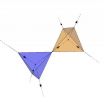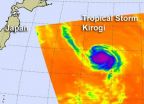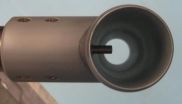(Press-News.org) Magnetic monopoles, entities with isolated north or south magnetic poles, weren't supposed to exist. If you try to saw a bar magnet in half, all you succeed in getting are two magnets, each with a south and north pole. In recent years, however, the existence of monopoles, at least in the form of "quasiparticles" consisting of collective excitations among many atoms, has been predicted and demonstrated in the lab. Now Stephen Powell, a scientist at the Joint Quantum Institute (JQI*) and the University of Maryland, has sharpened the theoretical framework under which monopoles can operate.
"Steady flows of magnetic monopoles are apparently impossible," Powell said, "but transient currents have been demonstrated, and one could imagine creating an alternating current, the magnetic equivalent of AC electricity." This so-called 'magnetricity' might be exploited for designing new kinds of high-density data storage.
The laws of electromagnetism predict a great symmetry between electric and magnetic forces. This equality does not extend, however, to isolated magnetic "charges." Isolated electric charges, in the form of electrons, are of course quite common. Such charges attract or repel each other with a force inversely proportional to the square of the distance between the charges. A positive charge and a negative charge can team up to form a neutral electric dipole. The situation in magnetism seems different: dipoles yes, monopoles no.
But new ideas and new experiments have changed the conventional thinking. First, experiments with cold electrons flowing in a two-dimensional sheet could, under the action of powerful magnetic fields, be coaxed into moving in circular orbits. These orbits in turn seem to interact to produce quasiparticles which have a charge equal to a fraction of the conventional electron charge. This was called the fractional quantum Hall effect. Could there be an analog for magnetic dipoles? Could circumstances allow the existence of isolated (or fractional) magnetic poles?
Recent experiments and Germany and France point to this possibility in so called "spin ice," a solid material made of the elements dysprosium (Dy), titanium (Ti), and oxygen (O). The basic building block of these materials is a pair of tetrahedral groupings, with (typically) two Dy atoms (each of which acts like a tiny dipole magnet of its own) pointing out of each tetrahedron and two pointing in. This is analogous to the orientation of hydrogen atoms in water ice, hence the name "spin ice."
Normally all magnetic poles should be confined within two-pole couplets---the traditional magnetic dipole. However, at a low enough temperature, around 5 K, "frustration" among the magnetic atoms---they want to align with each other but can't because of the inherent geometry of the material---leads to a disordered state with strong, synchronized fluctuations. Unpaired magnetic poles can form amid this tumult. That is, particles (quasiparticle excitations, to be exact) in spin ice with a net magnetic "charge" can exist and move about. A gas of electric charges is called a "plasma," so some scientists refer to the analogous tenuous cloud of magnetic charges as a "monopole plasma."
Stephen Powell's paper, published presently in the journal Physical Review Letters (**), explores what happens when the fluctuations are frozen by, for example, still-colder temperatures or a high-strength magnetic field. He shows how the monopoles are confined into magnetically neutral dipoles again. He is the first to prescribe the phase transition from the monopole phase (also called the Coulomb phase since the monopoles feel the same inverse-square force effect as electric charges) into the pole-confined phase.
Going to those lower temperatures, and observing how monopoles freeze into dipoles, will be difficult to achieve in the lab since it is hard to coax the magnetic atoms into interacting strongly enough. But Powell thinks it can be done. Furthermore, if this transition were like other phase transitions, then it should be subject to a body of laws called "universality," which typify many such phenomena---water turning into ice is a favorite example. Powell is the first to address how universality pertains to the freezing process, when monopoles in spin ice lapse back into dipoles at super-low temperatures.
"These kinds of magnetic monopoles are not just mathematical abstractions," said Powell. "They really appear. They can move around, at least a little bit. Scientists need to understand how monopoles behave, even at the lowest temperatures where they get locked back into dipoles." Powell's framework for monopoles includes testable predictions about how to observe the transition from monopoles into confined poles.
INFORMATION:
(*)The Joint Quantum Institute is operated jointly by the National Institute of Standards and Technology in Gaithersburg, MD and the University of Maryland in College Park.
(**) "Universal monopole scaling near transitions from the Coulomb phase," Physical Review Letters 109, 065701 (2012)
Stephen Powell, powell@umd.edu, 301-405-3078
Freezing magnetic monopoles
How dipoles become monopoles and vice versa
2012-08-10
ELSE PRESS RELEASES FROM THIS DATE:
NASA sees very heavy rainfall within Tropical Storm Ernesto
2012-08-10
NASA's Tropical Rainfall Measuring Mission satellite, known as TRMM can measure the rate rain is falling with a tropical cyclone from its orbit in space, and data from August 9 reveals areas of heavy rainfall in Tropical Storm Ernesto as it heads for a second landfall in Mexico.
The TRMM satellite saw tropical storm Ernesto on August 9, 2012 at 0656 UTC (2:36 a.m. EDT) after it moved from the Yucatan Peninsula into the Gulf of Mexico. An analysis of TRMM Microwave Imager (TMI) and Precipitation Radar (PR) rainfall shows that powerful convective thunderstorms were dropping ...
NASA sees Tropical Storm Kirogi headed for cooler waters
2012-08-10
Sea surface temperatures cooler than 80 degrees Fahrenheit can sap the strength from a tropical cyclone and Tropical Storm Kirogi is headed toward waters below that threshold on its track through the northwestern Pacific Ocean, according to data from NASA's Aqua satellite.
NASA's Aqua satellite passed over Tropical Storm Kirogi on August 9 at 0241 UTC. The Atmospheric Infrared Sounder (AIRS) instrument captured an infrared image of the cloud temperatures that showed a concentrated area of strongest storms and heaviest rainfall west of the center of circulation. Vertical ...
Height, weight and BMI changes seen in children treated with peginterferon alpha for hepatitis C
2012-08-10
Follow-up research from the Pediatric Study of Hepatitis C (PEDS-C) trial reveals that children treated with peginterferon alpha (pegIFNα) for hepatitis C (HCV) display significant changes in height, weight, body mass index (BMI), and body composition. Results appearing in the August issue of Hepatology, a journal of the American Association for the Study of Liver Diseases, indicate that most growth-related side effects are reversible with cessation of therapy. However, in many children the height-for-age score had not returned to baseline two years after stopping ...
BUSM/VA researchers uncover gender differences in the effects of long-term alcoholism
2012-08-10
(Boston) – Researchers from Boston University School of Medicine (BUSM) and Veterans Affairs (VA) Boston Healthcare System have demonstrated that the effects on white matter brain volume from long-term alcohol abuse are different for men and women. The study, which is published online in Alcoholism: Clinical and Experimental Research, also suggests that with abstinence, women recover their white matter brain volume more quickly than men.
The study was led by Susan Mosher Ruiz, PhD, postdoctoral research scientist in the Laboratory for Neuropsychology at BUSM and research ...
Soft autonomous robot inches along like an earthworm
2012-08-10
CAMBRIDGE, MA -- Earthworms creep along the ground by alternately squeezing and stretching muscles along the length of their bodies, inching forward with each wave of contractions. Snails and sea cucumbers also use this mechanism, called peristalsis, to get around, and our own gastrointestinal tracts operate by a similar action, squeezing muscles along the esophagus to push food to the stomach.
Now researchers at MIT, Harvard University and Seoul National University have engineered a soft autonomous robot that moves via peristalsis, crawling across surfaces by contracting ...
NASA's new way to track formaldehyde
2012-08-10
NASA scientist Tom Hanisco is helping to fill a big gap in scientists' understanding of how much urban pollution -- and more precisely formaldehyde -- ultimately winds up in Earth's upper atmosphere where it can wreak havoc on Earth's protective ozone layer.
He and his team at NASA's Goddard Space Flight Center in Greenbelt, Md., have developed an automated, lightweight, laser-induced fluorescence device that measures the levels of this difficult-to-measure organic compound in the lower troposphere and then again at much higher altitudes. The primary objective is determining ...
Thinking abstractly may help to boost self-control
2012-08-10
Many of the long term goals people strive for — like losing weight — require us to use self-control and forgo immediate gratification. And yet, denying our immediate desires in order to reap future benefits is often very hard to do.
In a new article in the August issue of Current Directions in Psychological Science, a journal of the Association for Psychological Science, researchers Kentaro Fujita and Jessica Carnevale of The Ohio State University propose that the way people subjectively understand, or construe, events can influence self-control.
Research from psychological ...
'Treating the whole person with autism' sets direction for parent-clinician collaboration
2012-08-10
NEW YORK, N.Y. (August 9, 2012) – Over 400 attendees from across the U.S. and around the world participated in the first national conference for families and professionals, "Treating the Whole Person with Autism: Comprehensive Care for Children and Adolescents with ASD."
Autism Speaks, the world's leading autism science and advocacy organization, organized and hosted the conference in collaboration with educational partners at Nationwide Children's Hospital (NCH), The Ohio State University Wexner Medical Center, the American Academy of Pediatrics (AAP), and the Health ...
Gecko feet hold clues to creating bandages that stick when wet
2012-08-10
VIDEO:
Researchers Alyssa Stark and Tim Sullivan test the adhesion of a geckos feet in water. Their findings may help improve the adhesion of bandages, sutures and similar items in moist...
Click here for more information.
Akron, Ohio, August 9, 2012 — Scientists already know that the tiny hairs on geckos' toe pads enable them to cling, like Velcro, to vertical surfaces. Now, University of Akron researchers are unfolding clues to the reptiles' gripping power in wet conditions ...
The cold power of Hurricane Gilma revealed by NASA satellite
2012-08-10
High, cold cloud tops with bitter cold temperatures are indicators that there's a lot of strength in the uplift of air within a tropical cyclone. NASA's Aqua satellite passed by Hurricane Gilma and saw a concentrated area of very cold cloud tops.
NASA's Aqua satellite passed over Hurricane Gilma on August 9 at 5:53 a.m. EDT. The Atmospheric Infrared Sounder (AIRS) instrument captured an infrared image of the cloud temperatures that showed the strongest storms and heaviest rainfall were wrapped around the storm's center. Cloud top temperatures in that area were as cold ...
LAST 30 PRESS RELEASES:
Autonomous AI agents developed to detect early signs of cognitive decline
Study finds ocean impacts nearly double economic cost of climate change
Increased deciduous tree dominance reduces wildfire carbon losses in boreal forests
Researchers discover how a respiratory bacterium obtains essential lipids from the human body and targets fat-rich tissues
Locust swarms destroy crops. Scientists found a way to stop that
More resources and collaboration needed to support prevention and treatment of obesity
Two types of underconfidence linked to anxiety and gender
Insects are victims too: Global study shows impacts of invasive alien species on populations
Pioneering natural, degradable polymer capsules
Forestry is becoming digital and automated
Maternity baby deaths much higher in northern England than in the South
Mosquitoes’ thirst for human blood has increased as biodiversity loss worsens
The stop-smoking medication varenicline may also work for cannabis use disorder
Potential new treatment for sepsis
Study reveals how many hours of video games per week might be too many
Electrospinning for mimicking bioelectric microenvironment in tissue regeneration
Home fingertip oxygen monitors less accurate for people with darker skin tones
Six weeks in a cast no less effective than surgery for unstable ankle fractures
Precautionary approach to alcohol-free and low alcohol drinks needed to protect public health, say experts
Gas-atomized Ca–Mg alloy powders produce hydrogen simply by adding water — high-efficiency hydrogen generation at room temperature
British redcoat’s lost memoir reveals harsh realities of life as a disabled veteran
World-leading rare earth magnet recycling facility launches in UK
Corday Selden selected for the Oceanography Society Early Career Award
MIT chemists determine the structure of the fuzzy coat that surrounds Tau proteins
Same moves, different terrain: How bacteria navigate complex environments without changing their playbook
Severe weather is deadly for vulnerable older adults long after the storm ends, study finds
Expert panel highlights opportunities for improving cancer studies
Hearing aid prescriptions not associated with changes in memory and thinking
Seth Zippel selected for The Oceanography Society Early Career Award
Jeremy Horowitz selected for The Oceanography Society Early Career Award
[Press-News.org] Freezing magnetic monopolesHow dipoles become monopoles and vice versa





